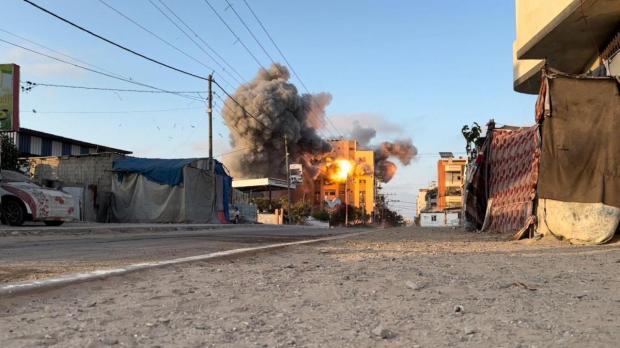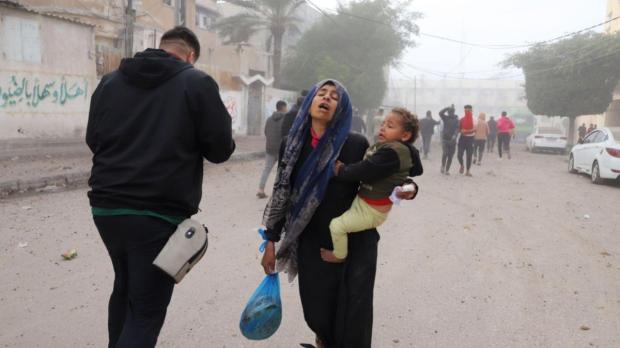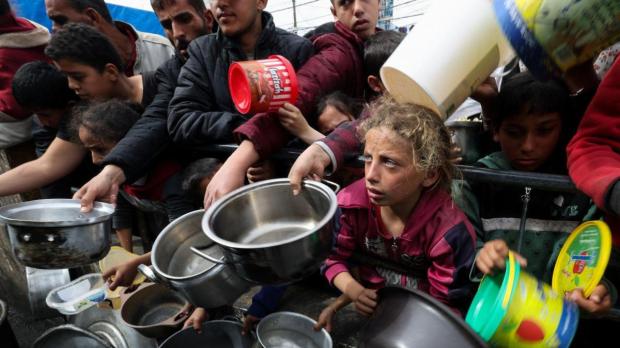October 7 marks the first anniversary of the Israel-Hamas war, a conflict that has left a devastating toll on both sides, particularly in Gaza. In response to this grim milestone, tens of thousands of people have taken to the streets worldwide, calling for an end to the bloodshed. From London to New York, Cape Town to Paris, pro-Palestinian demonstrators are rallying in a collective demand for peace across the Middle East.
In London, nearly 40,000 people marched through the city center, joining thousands more in global hubs like Paris, Rome, Manila, and New York City. In the US, protests have focused on the country’s support for Israel’s military campaigns, especially in Gaza and Lebanon, where violence has escalated. As tensions continue to rise, there are growing fears of an all-out war.

Latest airstrikes in Gaza kill 24
On the morning of October 7, Israeli airstrikes targeted Hamas-controlled areas in Gaza, killing at least 24 people and injuring 93 others. The strikes hit a mosque and a school near the Al-Aqsa Hospital in Deir al-Balah, where displaced Palestinians had sought refuge. The Israeli military justified the action, claiming the strikes targeted Hamas command centers embedded in civilian locations.
Since the outbreak of violence on October 7, 2023, when Palestinian militants attacked Israel, the toll on both sides has been staggering. Israel has reported 1,200 of its citizens killed, with 250 held hostage. On the other side, the Gaza Health Ministry claims that nearly 42,000 Palestinians have been killed due to Israeli retaliation. The war has displaced approximately 2.3 million people, exacerbating a humanitarian crisis. Genocide allegations have surfaced, with the International Court of Justice in The Hague investigating these claims—though Israel has denied any wrongdoing.
A timeline of events so far
October 7, 2023: War’s beginnings
One year ago, Hamas launched a surprise attack on Israel, firing rockets from Gaza and sending fighters across the border. This marked one of the most significant escalations in the ongoing conflict, igniting a war that continues to this day. In response, Israel declared a state of war and began a large-scale offensive against Hamas, particularly targeting Gaza. As part of its military strategy, Israel urged residents of Gaza to evacuate to the south, displacing over a million people.
Regional escalation: Houthi attacks in the Red Sea
The conflict has not been confined to Israel and Gaza. On October 19 last year, the US Navy intercepted missiles and drones launched by Yemen’s Houthi movement, a group aligned with Iran, which had targeted Israel. The Houthis have attacked Red Sea shipping lanes, stating their actions are in solidarity with Gaza. In response, the US, UK, and 12 other nations initiated “Operation Prosperity Guardian” to protect these shipping lanes.
In recent months, US military forces have launched strikes against the Houthis, leading to retaliatory explosions in Yemen’s capital, Sanaa, and other cities. The region remains on edge as the conflict widens.
Al Shifa hospital under siege
One of the most harrowing events of the past year was the Israeli siege of Al Shifa Hospital, Gaza’s largest healthcare facility, on November 15, 2023. The hospital, which housed over 5,000 displaced civilians, including patients, came under heavy fire. Power outages resulted in the deaths of 40 patients, including newborn babies. Al Shifa was not only a medical center but also a refuge for those fleeing the relentless airstrikes. The loss of life and infrastructure was a stark reminder of the war’s devastating toll on civilians.

Ceasefire negotiations and temporary truce
Amid the ongoing violence, there have been fleeting moments of hope for peace. After 48 days of intense fighting, Israel and Hamas agreed to a temporary four-day truce mediated by Qatar, Egypt, and the United States. This pause in hostilities allowed for the release of 50 hostages held by Hamas in exchange for 150 Palestinian prisoners held in Israel. Despite these efforts, Israel has refused calls for a full ceasefire, insisting that it would benefit Hamas.
In June, the UN Security Council passed its first resolution endorsing a ceasefire plan, but Israeli Prime Minister Benjamin Netanyahu remained skeptical, arguing that Israel must continue its mission to destroy Hamas. Ceasefire talks have continued, but no permanent agreement has been reached, and the violence shows little sign of abating.
Iranian connection and retaliation
Tensions have also escalated between Israel and Iran. On April 1 this year, Israeli airstrikes targeted Iran’s consulate in Syria, killing Brigadier General Mohammad Reza Zahedi, a top military official in Iran’s Islamic Revolutionary Guard Corps (IRGC). Iran’s supreme leader, Ayatollah Ali Khamenei, vowed retaliation, and within weeks, Iran launched over 300 rockets, missiles, and drones at Israel.
In response, Israeli forces intercepted most of the attacks, but the violence between the two nations raised fears of a broader regional war. Israeli Prime Minister Netanyahu warned Iran that they had made a “big mistake” and vowed further retaliation.
International Court of Justice on Israeli occupation
On July 19, the International Court of Justice (ICJ) ruled that Israel’s occupation of the West Bank and East Jerusalem violated international law. The court declared that Israel’s presence in Palestinian territories should end “as soon as possible”. The decision, based on the Hague Convention of 1907, reaffirmed that occupations must be temporary and cannot involve the transfer of sovereignty to the occupying power. The ruling has added pressure on Israel to justify its continued military presence in these regions.
Hezbollah leader Nasrallah killed in Lebanon
The conflict between Israel and Hezbollah in Lebanon reached a critical point in September this year when Israeli airstrikes killed Hassan Nasrallah, the group’s longtime leader. Nasrallah had been a central figure in Hezbollah for over three decades, and his death marked a significant blow to the Iran-backed group. In retaliation, Iran launched a large-scale missile attack on Israel in October, escalating the conflict further.
Rafah border: A lifeline amid crisis
As the violence intensifies, the Rafah border crossing between Gaza and Egypt has become a focal point for humanitarian aid. In the midst of the ongoing bloodshed, aid trucks have been allowed through this critical passage, providing much-needed food, water, medicines, and fuel to Gaza. In November last year, the first group of critically wounded evacuees crossed into Egypt as part of a Qatari-mediated deal.

While thousands of foreign nationals and severely injured Gazans have been able to leave, the majority of Gaza’s population remains trapped. The Rafah border continues to be the main point of international negotiations and the only entry for relief supplies into the besieged region.
A year of war and uncertainty
As the Israel-Hamas war enters its second year, the toll on civilians, infrastructure, and regional stability continues to mount. The global protests calling for peace highlight the growing frustration with the seemingly endless cycle of violence. While there have been moments of diplomacy and brief ceasefires, the path to a lasting resolution remains elusive. For the millions of people affected by the conflict, the hope for peace remains, but so does the fear of further bloodshed.

